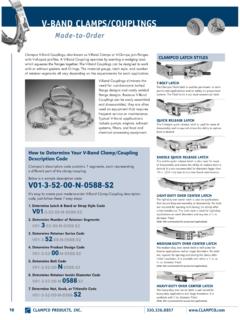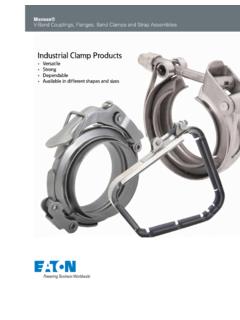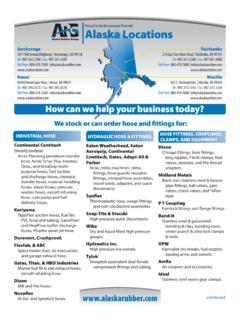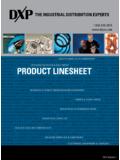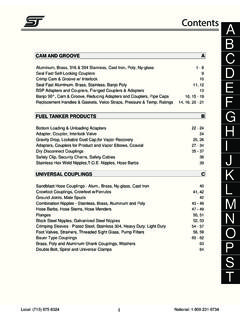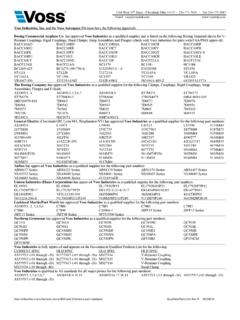Transcription of OFFSHORE TECHNOLOGY REPORT 2001/038
1 HSEH ealth & SafetyExecutiveTemporary/permanent piperepair - GuidelinesPrepared by AEA TECHNOLOGY Consultingfor the Health and Safety ExecutiveOFFSHORE TECHNOLOGY REPORT2001/038 HSEH ealth & SafetyExecutiveTemporary/permanent piperepair - GuidelinesAEA TECHNOLOGY ConsultingE1 CulhamAbingdonOxfordshireOX14 3 EDUnited KingdomHSE BOOKSii Crown copyright 2001 Applications for reproduction should be made in writing to:Copyright Unit, Her Majesty s Stationery Office,St Clements House, 2-16 Colegate, Norwich NR3 1 BQFirst published 2001 ISBN 0 7176 2069 7 All rights reserved. No part of this publication may bereproduced, stored in a retrieval system, or transmittedin any form or by any means (electronic, mechanical,photocopying, recording or otherwise) without the priorwritten permission of the copyright REPORT is made available by the Health and SafetyExecutive as part of a series of reports of work which hasbeen supported by funds provided by the the Executive, nor the contractors concernedassume any liability for the reports nor do theynecessarily reflect the views or policy of the SUMMARYThis document provides guidance on the applicability of a range of pipe repair clampsand pipe connectors to a range of pipe repair scenarios.
2 These repair scenarios cover themost common types of damage/deterioration to piping systems, such as internal andexternal corrosion, and also cover situations where the damage is extensive. Repairclamps are typically used where the damage is localised and pipe connectors are usedwhere the damage is more extensive. Examples of the different types ofdamage/deterioration are explained and the different types of clamps and connectors thatare commonly used are guidance provided in this document includes the limitations of the different types ofrepair components with respect to operating pressure, operating temperature, andlongevity (temporary or permanent repair).
3 Classification of the repair in terms of being atemporary repair or a permanent repair is provided within the context of fitness-for-purpose and special consideration is given to the repair of safety critical piping guidance document is primarily concerned with the use of metallic repaircomponents, however, as composite materials are finding increasing applications to piperepair situations, this document also provides a review of the use of composite vCONTENTSEXECUTIVE SCOPE OF LAYOUT OF DOCUMENT12. LITERATURE DATABASE THE OTHER SOURCES OF SUMMARY OF LITERATURE REVIEW RESULTS43. PIPE REPAIR PIPE SUBJECT TO EXTRNAL METAL PIPE SUBJECT TO INTERNAL METAL PIPE SUBJECT TO LEAKAGE84.
4 RANGE OF AVAILABLE REPAIR CLAMPS AND REPAIR9 REPAIR REPAIR COUPLINGS AND CONNECTORS145. APPLICABILITY OF DIFFERENT REPAIR COMMON REPAIR APPLICABILITY TO REPAIRS ON SAFETY CRITICAL QUICK REFERENCE SUMMARY TABLE216. REVIEW OF THE USE OF COMPOSITE MATERIALS23 FOR THE REPAIR OF SCOPE OF TYPES OF COMPOSITE DESIGN IMPORTANT ASPECTS OF COMPOSITE DOCUMENTATION/DATA FIRE INSPECTION OF COMPOSITE REPAIRS287. TRACK RECORD OF DIFFERENT REPAIR29 CLAMPS/CONNECTORS8. CATEGORISATION OF REPAIRS (TEMPORARY OR31 PERMANENT)vi9. PIPE REPAIRS USING PIPE CLAMPS/CONNECTORS33 OTHER CONSIDERATIONSREFERENCES34 APPENDIX 1 PRINT-OUT OF DATABASE SEARCH RESULTS35 APPENDIX 2 PRINT-OUT OF ABSTRACTS OF RELEVANT59 REFERENCES11.
5 INTRODUCTIONThis Guidance Document is aimed at providing information on the range of available pipe repaircomponents that are applicable to a range of repair scenarios. Piping systems and pipework canfail in a number of ways. The most commonly experienced failures, or threatened failures, areassociated with either internal or external corrosion of the pipe wall. Other failures may involveother metal loss mechanisms, such as erosion, fretting/chafing or gouging. Repairs may beeffected on-line using simple band-type clamps or patches or may involve the replacement of asection of pipe or pipework in conjunction with pipe couplings/connectors. There are a number ofproprietary repair components/systems in existence, involving both metallic and compositematerials, but these systems may have certain limitations regarding their applicability against arange of repair scenarios.
6 This Guidance Document, therefore, is aimed at providing guidelineson the applicability of a range of these devices/systems against the different repair scenarios andservice/duty requirements, together with the requirements for the medium and long-terminspection/monitoring of the repair to ensure continuing fitness for intended purpose . SCOPE OF DOCUMENTThe scope of this document involves the use of pipe repair clamps and connectors. This documentalso provides a review of the use of composite materials for the repair of pipework. Thisdocument does not, therefore, provide guidelines on other pipe repair methods, such as by-passrepairs using hot-taps and stopples, slip-lining repairs using plastic liners, and repairs usingweld overlays to re-instate the pipe , piping, piping components, and pipework are all terms often used when describingpipework and piping systems.
7 This guidance document is concerned with the repair of pipework the term pipework referring to an arrangement of pipes and pipe fittings ( elbows, bends, tees,reducers, flanges). This guidance document does not, therefore, cover the repair of non-pipeworkitems such as valves, filters are specific examples of pipework and piping systems used to convey fluids oversignificant distances. Although these guidelines have been specifically produced to address aboveground pipework and piping systems, they may equally be applicable to buried pipelines andsubmarine pipelines (buried or not). Some of the repair concepts discussed in these guidelinesrequire consideration of the restraint of axial loadings which, in the case of buried pipelines, maybe automatically accommodated (restraint afforded by pipe/soil friction etc.)
8 These guidelines apply to the repair of carbon steel pipe and pipework only. Other metallicpipe/pipework, such as stainless steel, duplex stainless steel, copper nickel etc., may present otherfactors for consideration ( weldability, surface treatment/preparation agents for compositematerials etc.), and are outwith the scope of this LAYOUT OF DOCUMENTThis document is primarily concerned with metallic mechanical clamps and connectors as usedfor the repair of damaged/deteriorated pipe components. As composite materials are findingincreasing applications to pipe repair situations, a review of their use is presented in section 6 ofthis document. All other sections of this document, including the section presenting the results ofthe literature searches, are primarily concerned with the use of metallic mechanical clamps andconnectors for the repair of damaged/deteriorated pipe LITERATURE REVIEWA number of sources of information have been accessed in order to glean information concerningthe state-of-the-art of pipework repair systems/components.
9 These sources of information consistof, in the main, known databases that hold references of publications (articles etc.), but aresupplemented by other non-direct information sources, such as the 6 of this guidance document presents a review of the use of composite materials for therepair of pipework, and presents the work that is currently being carried out within the WorkingGroup on pipe repairs using composite materials. The literature review presented in this sectionof the document, therefore, concentrates on metallic mechanical repair sleeves, clamps, andcouplings/connectors, but also considers the use of un-reinforced composite materials ( epoxyresin without any reinforcement material) used in conjunction with metallic repair DATABASE SEARCHESA number of database searches have been conducted in order to identify current and pastactivities relating to the use of pipework repair systems/components.
10 The databases chosen werebased on knowledge of their popularity and coverage of the subject matter Engineering, Energy,Science and TECHNOLOGY . The following databases have been accessed: The Energy TECHNOLOGY Data Exchange (ETDE) this database is hosted by the UnitedState s Department of Energy (USDOE) for the International Energy Agency (IEA) which isan international consortium that collects and exchanges research and TECHNOLOGY informationthrough the Energy Database . The Energy Database covers all aspects of energy technologyand its environmental effects, covering all energy sources (including fossil fuels), energyconservation and energy policy. COMPENDEX this database is hosted by Energy Information Inc.










